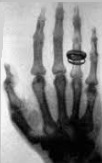| www.tmatlantic.com
Test & Soldering Equipment On-line Store |
|
D.E.V.I.C.E. (Wiki)Calculators Services |
|||||
Filter by first letter
|
Discovery of X-rays
Om November 8, 1895 Wilhelm Conrad Röntgen discovered X-rays. This happened unexpectedly. Late in the evening when the scientist was going to leave the laboratory and had already turned off the light in the room he suddenly saw a greenish glow in the darkness, fluorescence, which emanated from the screen covered with barium platinum-cyanide crystals. Wilhelm Conrad Röntgen found out that this happened due to the reaction of the crystals to the action of a nearby electrovacuum (crookes) tube which was at that moment under high voltage. After the current was turned off the glow of the screen disappeared. Since the tube was wrapped in black opaque paper the scientist suggested that when an electric current passed through the tube it emitted some kind of invisible rays that could penetrate opaque media and excite barium crystals. Wilhelm Röntgen called these invisible and unknown to science rays “X-rays”. Röntgen made a series of experiments in his laboratory. He found that X-rays could penetrate human flesh but couldn’t penetrate higher density substances (bones, lead), and they could also be photographed. On December 22, 1895 he managed to take the first pictures using x-rays. It was the picture of his wife’s hand. The image showed bones, soft tissue and a clearly visible wedding ring on her finger. |
Site mapPrivacy policyTerms of Use & Store PoliciesHow to BuyShippingPayment




|

























